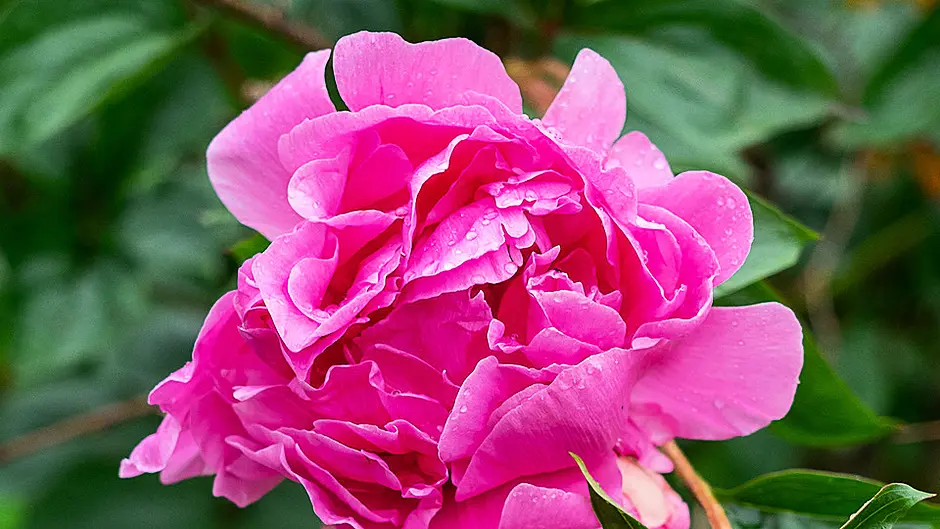BY JOYCE RUSSELL
IN the interval between my writing this and going to print, I’m hoping we have had some rain. It’s in the forecast for sure, but forecasts often change and whether we get enough to really wet the soil is another thing. Scrape the surface with a finger or a hoe and you will soon find out. If only the top layer is damp and it is dry underneath, then you still need to get some moisture down to the roots of plants.
Water wise
A nationwide hosepipe ban is in place for the next few weeks. This makes watering difficult if you have a large garden, but there are lots of techniques that you can put into practice:
• If the rain does its job and everything is thoroughly wet, then cover bare soil with a mulch to help keep moisture in the ground if things start to dry out again.
• Use large containers to collect any run off from gutters. You’ll be surprised at how much water you can collect from a large roof in a light rain shower.
• Swap the hosepipe for a watering can.
• Get the whole family involved to bail out the bath and reuse the water. Form a chain with adults in the house and children outdoors if you want to avoid wet carpets. Teach kids how to water plants carefully and you will be surprised how competent they can be.
• Put a plug in the bath if your shower runs into one and reuse shower water in the same way.
• Washing up water can be too soapy and greasy for small plants, so use it around larger established ones and try not to splash leaves.
• Prioritise what gets water. Deep rooting plants can survive longer than shallow rooting ones.
• Make a small depression round plants. Water into this so water stays and soaks down where it is needed rather than running away.
• Remember that we always return to the normal of too much rain, so any short term actions until then are worth it to keep plants growing.
Ripening fruit
Redcurrants are ripening on the bushes and these are a favourite food for some birds. Raspberries and blackcurrants aren’t far behind and all berries are on the bird radar as they develop full colour and sweeten. Even if you have carefully covered the bushes with netting, it is worth doing a check every few days. Weight edges down carefully so blackbirds can’t sneak underneath. Check the surface of the net too and mend any holes. Small birds can get in but often can’t find their way out again.
It can be a bit of a brain puzzle to stare at netting and spot any breaks, so be systematic and train your eye to what you need to see. Ideally you should use rot-proof thread or string that will last for as long as the net. In practice I often use any bit of string I have in a pocket and know I will have to do a more permanent job at a later date.
Perfect peonies
These large flamboyant flowers make a big splash in any garden border. The buds are lovely too – keep plants watered if ground is dry so these open and reach their full potential. The flower stems are pretty strong, but tall varieties can break in a direct wind. Use twiggy sticks to keep the plant supported and to allow a small amount of movement but not enough for stems to snap.
Remove flower heads that are past their best and leave the foliage to provide a backdrop to other plants when the peony display is finished.
Look out for purple, white and orange varieties to ring the changes from pink flowers.
Carrots and beetroot
Check beetroot growing in rows and see if some are ready to lift and use. If you have sown thickly and haven’t thinned plants out, then this is a good time to do so. Thinnings may well have useable roots at this point and these tiny offerings are truly delicious. Firm the soil back around plants left in the ground. This helps support the stem and creates a firm and stable root run. It’s a good idea to water rows after thinning too. You don’t want to set any remaining plants back by loosening roots and leaving them in dry soil.
Carrots will produce bigger roots if they are thinned to at least 5cm apart in the row. Competition for nutrients is reduced and they have room to expand as they grow. Always thin and weed carrots on a dull, or even damp, day and keep rows covered with insect-proof mesh if you want to avoid damage from carrot fly.
Sow now
Lettuce and rows of salad leaves. Parsley, spinach, Swiss chard, turnip, radish, pak choi, runner beans, peas.








